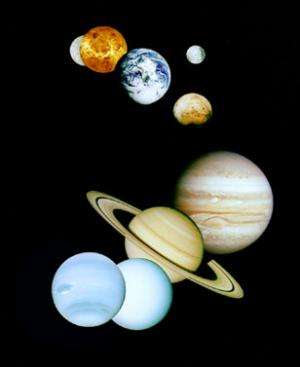STAR TRAK: September 2012

Saturn will come into view about an hour after sunset in early September. At mid-northern latitudes, look for the yellow planet about 10 degrees high in the west-southwest well to the lower left (south) of the bright orange star Arcturus. Saturn will sink lower each day, and by month's end it will disappear into bright twilight an hour after sunset. It will pass behind the sun in late October, reappearing in the morning sky a few weeks later.
Mars will be about 10 degrees to the left (south) of Saturn on Sept. 1, but the red-orange planet will move rapidly eastward as the days pass, leaving Saturn behind. Mars will set about two hours after the sun each night for the rest of this year.
Mercury will be too close to the sun during September to observe without a telescope. Only those with an unobstructed view of the western horizon will be able to see it at all.
Jupiter will rise shortly before midnight local time at the beginning of the month and two hours earlier by month's end. It will be about two-thirds of the way from the southern horizon to overhead when it reaches its highest point in the south near dawn.
Dazzling white Venus will rise around 3 a.m. local time during September and be about a third of the way up the eastern sky by the middle of morning twilight. On Sept. 12, the crescent moon will be a few degrees southwest of Venus, which will be about the same distance southwest of the Beehive Star Cluster, a beautiful sight in binoculars.
Aurora
On a clear September night you may be lucky enough to see an aurora (sometimes called "northern lights"). These silent ribbons and curtains of light can appear whenever the sun is active, but they are especially likely from August to October.
Eruptions from the sun's surface hurl enormous amounts of charged particles into space, and when some of these solar particles head in our direction, they cause auroral activity. Details and photographs are available online. You can watch for auroras when they are most likely to happen by checking sites such as the Space Weather Prediction Center and SpaceWeather.com, which also has a page featuring sightings of auroras.
Equinox
The sun will reach the September equinox on Sept. 22 at 10:49 a.m. EDT (14:49 Universal Time) marking the start of autumn in the Northern Hemisphere and spring in the Southern Hemisphere. For the next six months in the Northern Hemisphere, the nights will be longer than the days.
Moon phases
The moon will be at third quarter on Sept. 8, new on Sept. 15, at first quarter on Sept. 22 and full on Sept. 29 (the Harvest Moon, which is the full moon closest to the September equinox).
Provided by Indiana University




















